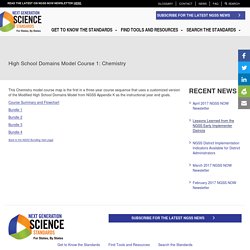

About Putt Putt Boat Engines – SciencetoyMaker. HS ChemEnergy Teacher Guide v1.0. Crosscuttingconceptsprompts. Ngsstaskformats feb2016 v4 1 1. NGSS Chemistry Resources. Chemistry Project Ideas. Overview - Baliga Systems Education Experiences. Interactive Periodic Table of Elements Shows How the Elements Actually Get Used in Making Everyday Things. Keith Enevoldsen, a software engineer at Boeing, has created an Interactive Periodic Table of Elements.

As you might expect, the table shows the name, symbol, and atomic number of each element. But even better, it illustrates the main way in which we use, or come into contact with, each element in everyday life. For example, Cadmium you will find in batteries, yellow paints, and fire sprinklers. Argon you'll encounter in light bulbs and neon tubes. And Boron in soaps, semiconductors and sports equipment. The Interactive Periodic Table of Elements (click here to access it) is a handy tool for chemistry teachers and students, but also for anyone interested in how the elements make a chemical contribution to our world. Follow Open Culture on Facebook and Twitter and share intelligent media with your friends. If you'd like to support Open Culture and our mission, please consider making a donation to our site. Via Mental Floss Related Content: Periodic Table Battleship! OrionsQuest.org - Space Based Research for Today's Youth.
Chris Kesler. Phenomena for NGSS. The Connected Chemistry Curriculum. Project Search. Create & Find Free Multimedia Lessons. Create & Find Free Multimedia Lessons. Using Phenomena in NGSS. Anchor Design Problems March2016. NGSS Assessment Portal. How to test Rochelle salt piezoelectric crystal. Needing some piezoelectric crystals I decided to make some rochelle salt crystals.

I've detailed the steps on my how to make rochelle salt crystals page. Once I had a crystal I then proceeded to test its piezoelectricity as detailed below. Note that this test procedure can be used with pretty much any type of piezoelectric crystal. The following diagram is intended to explain why you get a positive spike if the oscilloscope probe is hooked up one way and a negative spike if it's hooked up the other way, as is demonstrated above. Notice in the diagram below that in both cases the electrons in the crystal move the same way during the tap.
The spike you see on the scope output represents what happens at the ungrounded probe tip. If neither of the probe tips were grounded then the scope output would be two lines that start out touching but then briefly move equally apart from each other, one in the positive direction and the other in the negative. Other Piezoelectricity explorations. High School Domains Model Course 1: Chemistry.
Skip to main content High School Domains Model Course 1: Chemistry This Chemistry model course map is the first in a three-year course sequence that uses a customized version of the Modified High School Domains Model from NGSS Appendix K as the instructional year end goals.

Course Summary and Flowchart Bundle 1 Bundle 2 Bundle 3 Bundle 4 Back to the NGSS Bundling main page. Online Labs for schools - Developed by Amrita University and CDAC Online Lab.
Bundle 2 "Chemical Reactions" Bundle 3 "The Flow of energy" Bundle 4 "The Materials We Need" 5E Model. Next Generation Science Standards. Phenomena are an essential part of implementing the NGSS.

But what are phenomena, and how can they be used? This brief resource about phenomena was developed for educators, and describes how phenomena can be used in NGSS classrooms to drive teaching and learning. In addition, the three minute video interview below with Brian Reiser introduces phenomena and their connection to the NGSS and three-dimensional learning: External Resources About Phenomena Qualities of a good anchor phenomenon - a resource from the Research + Practice Collaboratorywww.ngssphenomena.com - a collection of interesting phenomena that could be instructionally productiveVideo discussing phenomena in the context of evaluating instructional materials. Criteria for Evaluating a Phenomenon. Databases - Oak Harbor High School Library.
Anchor Design Problems March2016. Using Phenomena in NGSS. Ed and Periodic Videos. Collaboration between classes... physics and chemistry. From the Flinn Lab: Freezing by Boiling.